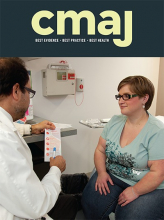Jump to comment:
- Page navigation anchor for Highlighting obesity as a risk factor for endometrial cancerHighlighting obesity as a risk factor for endometrial cancer
On behalf of the Community of Practice (CoP) in Obesity of the Society of Gynecologic Oncology of Canada (GOC), we would like to thank the authors of the recent guideline on the management of obesity in adults (1) for highlighting the elevated risk of endometrial cancer among women with obesity. Endometrial cancer is the fourth most common gynaecologic malignancy in women with 7,400 new diagnoses annually in Canada (2). Obesity is one of the most significant risk factors for this disease: the risk is tripled in women with a body mass index (BMI) above 30 kg/m2. (3)
We advocate for increasing provider and public awareness of the association between obesity and endometrial cancer. In addition, we want to highlight that abnormal uterine bleeding or post-menopausal bleeding are red flags that require urgent assessment with an office endometrial biopsy. Endometrial biopsy is essential for diagnosis and cannot be replaced by imaging. Furthermore, young women with obesity and irregular menstrual cycles are at an increased risk for the development of endometrial hyperplasia and cancer. Management strategies for endometrial protection include: progestin-containing intrauterine devices (4) and the oral contraceptive pill (5).
Aligning with the authors’ recommendation to focus on patient-centred health outcomes rather than weight loss alone,1 such risk-reducing interventions should routinely be offered to women with obesity, particularly in the setting of infrequent...
Show MoreCompeting Interests: None declared.References
- Sean Wharton, David C.W. Lau, Michael Vallis, et al. Obesity in adults: a clinical practice guideline. CMAJ 2020;192:E875-E891.
- Canadian Cancer Society. Canadian Cancer Statistics 2019. Accessed from: https://www.cancer.ca/~/media/cancer.ca/CW/cancer%20information/cancer%20101/Canadian%20cancer%20statistics/Canadian-Cancer-Statistics-2019-EN.pdf?la=en on September 30, 2020.
- Amant F, Moerman P, Neven P, Timmerman D, Van Limbergen E, Vergote I. Endometrial cancer. Lancet. 2005;366(9484):491-505.
- Jareid M, Thalabard JC, Aarflot M, Bovelstad HM, Lund E, Braaten T. Levonorgestrel-releasing intrauterine system use is associated with a decreased risk of ovarian and endometrial cancer, without increased risk of breast cancer. Results from the NOWAC Stu
- Collaborative Group on Epidemiological Studies on Endometrial C. Endometrial cancer and oral contraceptives: an individual participant meta-analysis of 27 276 women with endometrial cancer from 36 epidemiological studies. Lancet Oncol. 2015;16(9):1061-107
- Page navigation anchor for Clinicians need long-term support for the management of obesityClinicians need long-term support for the management of obesity
Congratulations Wharton and colleagues for the comprehensive practice guideline on obesity management [1]. I agree that many multicausal and multidimensional interacting factors influencing obesity and their consequences. There are two 'physician' aspects worth mentioning.
First, obesity affected 27.7% or 7.6 million Canadian adults in 2019. The authors are right with the regularly assessment step "Direct measurement of height, weight and waist circumference and calculation of body mass index (BMI) should be included in routine physical examination for all adults.“ [1] A current data analysis of the Canadian primary care electronic medical records with 707,819 patients aged 40 or older showed that 58.6% had at least one BMI recording but only 11.5% had at least one waist circumference (WC) documentation. However, in 81% of Canadian patients there was no simultaneous monitoring of BMI and WC by primary care clinicians [2].
Second, obesity education currently has a very low priority in medical school curricula, with an average of just 10 hours over four years [3]. Medical students are by no means sufficiently prepared to manage patients with obesity - especially nutrition competencies are enormously deficient across the globe [4, 5]. In addition to this helpful practice guideline, primary care clinicians need urgent long-term support for the management of obese patients.
Competing Interests: None declared.References
- 1. Sean Wharton, David C.W. Lau, Michael Vallis, et al. Obesity in adults: a clinical practice guideline. CMAJ 2020;192:E875-E891.
- 2. Lindeman C, et al. Body mass index and waist circumference documentation in Canadian primary care electronic medical records. Research Square 14 Jul, 2020. https://assets.researchsquare.com/files/rs-41280/v1/7fdfdc99-bc4a-4d9a-9046-661841aea57e.pdf
- 3. Butsch WS, et al. Low priority of obesity education leads to lack of medical students' preparedness to effectively treat patients with obesity: results from the U.S. medical school obesity education curriculum benchmark study. BMC Med Educ 2020;20:23.
- 4. Mastrocola MR, Roque SS, Benning LV, Stanford FC. Obesity education in medical schools, residencies, and fellowships throughout the world: a systematic review. Int J Obes (Lond) 2020;44:269-79.
- 5. Crowley J, Ball L, Hiddink GJ. Nutrition in medical education: a systematic review. Lancet Planet Health 2019;3:e379-89.
- Page navigation anchor for RE: Obesity in adults: a clinical practice guidelineRE: Obesity in adults: a clinical practice guideline
The CMAJ and its peer reviewers concluded an article written by over 50 authors many sponsored by the pharmaceutical industry with over 80 recommendations would be of practical use to primary health care providers .
Show More
Having a BMI over 25 or over is labelled as having the “disease” of obesity . Yet a 2013 study by Health Canada (1) found at age 20 the life expectancy for females[males] with BMI 18.5 to 24.9 (”normal” )was 62.9[57.2] years , who had a BMI 25 to 30 “overweight” was a further 66.5[ 61.0] years and for a BMI 30 to 35, otherwise known as Class 1 obesity, 64.6 [59.1] years . Both “overweight” males and females had a significantly longer life expectancy than those with normal weight . Those with Class 1 obesity still had a longer life expectancy than those with “normal” weight .
A 2018 study (2) of populations in England, Finland, France and Finland between ages 50 and 75 found negligible if any differences in life expectancy between individuals with normal weight ( BMI 18.5- 24.9) overweight ( BMI 25-29.9 ) and class 1 obesity ( BMI 30 to 34.9)
One of the CMAJ recommendations states pharmacotherapy should be considered for individuals with a BMI over over 30 . For the reasons above this would suggest the guideline recommendations for pharmacotherapy are based more on cosmetic considerations rather than health indications.
Stigmatizing those who are “overweight” or have class 1 obesity by calling their condition a disease is not based...Competing Interests: None declared.References
- Sean Wharton, David C.W. Lau, Michael Vallis, et al. Obesity in adults: a clinical practice guideline. CMAJ 2020;192:E875-E891.
- . Steensma C., Loukine L, Orpana H, Lo E, Choi B, Water C et l. Comparing life expectancy and health adjusted life expectancy by body mass index categoryin adult Canadians: a descriptive study . Popul Health Metr 2013 11; 11 :21
- . Stenholm S, Head J , V Aalto et al. Body mass index as a predictor of healthy and disease free life expectancy between ages 50 qnd 75: a multicohort study. International Journal of Obesity . 2017; 41(5) : 769-775
- Page navigation anchor for RE: Obesity in adults: a clinical practice guideline.RE: Obesity in adults: a clinical practice guideline.
As a family doctor in Alberta, I wanted to congratulate all those concerned, on the excellent job undertaken for the production of this CPG. Thank you and well done.
Competing Interests: None declared.References
- Sean Wharton, David C.W. Lau, Michael Vallis, et al. Obesity in adults: a clinical practice guideline. CMAJ 2020;192:E875-E891.
- Page navigation anchor for Nutrition advice for women with obesity – a collective responsibilityNutrition advice for women with obesity – a collective responsibility
Wharton et al. provide a comprehensive resource for effective and ethical obesity management, across many populations and patient circumstances[1]. The specific focus on adult women living with obesity is welcomed, especially as pregnancy, preconception and postpartum are some of the most critical life-course timepoints for the prevention of non-communicable diseases across multiple generations[2]. The authors outline that where possible, adults living with obesity, which includes women of reproductive age, should have access to a registered dietitian for individualized medical nutrition therapy[1]. This is an excellent recommendation, and we also consider it important to advocate that all healthcare providers who see women with obesity, have an opportunity to promote healthy weight and nutrition[3,4]. Due to the growing prevalence of obesity and the associated demand on dietetic services, other healthcare professionals must capitalize on their contact with women and promote healthy behaviour change. It is important that nutrition is seen as a collective global responsibility and is embedded into multi-disciplinary health services, systems and policies[3,4]. The authors recommend that primary care physicians encourage and support pregnant women with obesity to consume a healthy dietary pattern[1]. Advice on how physicians can implement this into their practice, however, is lacking in this review. During pregnancy, women with obesity should be advised to follow a diet that...
Show MoreCompeting Interests: None declared.References
- 1. Sean Wharton, David C.W. Lau, Michael Vallis, et al. Obesity in adults: a clinical practice guideline. CMAJ 2020;192:E875-E891.
- Mark A. Hanson, Chandni Maria Jacob, Moshe Hod, et al. The FIGO pregnancy obesity and nutrition initiative (PONI). Int J Gynecol Obstet. 2019; 147: 131– 133.
- Jacob CM, Killeen SL, McAuliffe FM et al. Prevention of noncommunicable diseases by interventions in the preconception period: A FIGO position paper for action by healthcare practitioners. Int J Gynecol Obstet. 2020; 151(Suppl 1): 6– 15.
- McAuliffe FM, Killeen SL, Jacob CM, et al. Int J Gynecol Obstet. 020;151(Suppl 1):16–36.
- ACOG Committee Opinion No. 680 Summary: The Use and Development of Checklists in Obstetrics and Gynecology. Obstet Gynecol. 2016; 128: 1200.
- Page navigation anchor for RE: Obesity in AdultsRE: Obesity in Adults
I was initially pleased to see an update on obesity management presented to bring us up to date on the exciting changes in the weight management paradigm.(1)
Unfortunately, as many consensus articles will do I found it lacked some of the not so new thoughts on the bodies hormonal response to macronutrients and presented the old, calories in, calories out statements. Several commercial products were noted but the words insulin, insulin resistance or hyper insulinemia were no where to be seen. The high insulin levels seen in Metabolic Syndrome is the driver of Type 2 Diabetes, hypertension, obesity, some cancers and dementia. It is time that we all become aware of the amazing results that we are getting treating this very easily diagnosed and clearly treatable metabolic issue.(2,3)Competing Interests: None declared.References
- 1. Sean Wharton, David C.W. Lau, Michael Vallis, et al. Obesity in adults: a clinical practice guideline. CMAJ 2020;192:E875-E891.
- 2. Fung J. The Obesity Code: Unlocking the Secrets of Weight Loss. 2016: Greystone Books.
- 3. Barazzoni R, Cappellari G, Ragni M, et al. Insulin Resistance in obesity: an overview of fundamental alterations. Eat Weight Disord. 2018;23:149-157.
- Page navigation anchor for RE: Obesity in adults: a clinical practice guidelineRE: Obesity in adults: a clinical practice guideline
I applaud the herculean effort of Wharton et al. to produce timely and comprehensive guidelines on the management of obesity [1], and offer the following comments:
First, despite the wide array of topics covered I am surprised and disappointed that guidelines related to the prevention of obesity are conspicuously absent. With billions of dollars spent annually in Canada towards dietary, pharmacologic, surgical and psychological strategies to treat obesity and its many complications, it is unfortunate that so little attention and resources are dedicated to preventing obesity in children, adolescents and young adults. Perhaps a companion guideline focusing on primary prevention is in the works.
Second, the guideline recommendation format, though well-intentioned, seems unwieldy and, at times, confusing [2]. For example, under pharmacotherapy in obesity management, there are three recommendations, all categorized as having the same level of evidence (Level 2a, Grade B), yet these separate recommendations state that pharmacotherapy “can be used”, “may be used”, and is “recommended”. For clinicians looking for guidance on ‘what to do’, these statements appear ambiguous and inconsistent with the evidence. Rather than adopting a guideline recommendation scheme that is rather outdated [2], there are newer and simpler schemes that provide a more practical approach to treatment recommendations: ‘do it’, or ‘OK to do it or not do it’ [3].
As a third (minor) p...
Show MoreCompeting Interests: None declared.References
- 1. Sean Wharton, David C.W. Lau, Michael Vallis, et al. Obesity in adults: a clinical practice guideline. CMAJ 2020;192:E875-E891.
- 2. Shekelle PG, Woolf SH, Eccles M, et al. Developing clinical guidelines. West J Med 1999;170:348-51.
- 3. Neumann I, Santesso N, Akl EA, et al. A guide for health professionals to interpret and use recommendations in guidelines developed with the GRADE approach. J Clin Epidemiol 2016;72:45-55.
- 4. Lau DCW, Douketis JD, Morrison KM, et al. 2006 Canadian clinical practice guidelines on the management and prevention of obesity in adults and children [summary]. CMAJ 2007;10;176:S1-13.
- 5. Douketis JD, Feightner JW, Attia J, Feldman WF. Periodic health examination, 1999 update: 1. Detection, prevention and treatment of obesity. Canadian Task Force on Preventive Health Care. CMAJ 1999;160:513-25.
- Page navigation anchor for RE: Permission for advice?RE: Permission for advice?
Patients frequently see physicians for obesity related diseases such as diabetes, hypertension or arthritis and joint pain. The guidelines seem, to me at least, to suggest that physicians should ask for permission before discussing weight and by inference weight loss. While this approach has merit it would be unnecessary if patients asked for help with weight loss. Many it seems do not.
An alternative to asking permission to discuss 'weight' is to respectfully advise, when it is the case, that weight loss could help improve the illness which is causing suffering or for which patient is seeking assistance with managing. One can educate patients that weight loss is or could be beneficial with a reduced risk of fat shaming since improvement depends upon an individual patient and need not involve making or communicating a normative assessment such as BMI.
I would go so far to state, and believe that physicians are in fact OBLIGATED to ensure that patients are aware of the beneficial effects of weight loss when suffering from obesity related conditions.
I am sorry your diabetes has proven so difficult to manage. Have other physicians explained that weight loss and regular exercise could improve your diabetic control? I would like to talk to you about weight loss....(Pause)
."Sure great doc"
No response?
Is this alright with you?Competing Interests: None declared.References
- Sean Wharton, David C.W. Lau, Michael Vallis, et al. Obesity in adults: a clinical practice guideline. CMAJ 2020;192:E875-E891.
- Page navigation anchor for RE: Obesity in adults: a clinical practice guidelineRE: Obesity in adults: a clinical practice guideline
Obesity, like the current COVID-19 pandemic, has long been treated as a public health crisis. However, obesity is not a simple contagious disease like COVID-19. It is a complex, multifaceted condition that has been medicalized to oblivion, to the point where it is commonly referred to as a chronic disease. Understanding the origin of BMI, the measure used to define obesity, provides valuable insight into obesity itself. BMI was first calculated by a Belgian astronomer and was never meant to be used in the health sciences.(2) It was a simple mathematical calculation, a statistical instrument, developed using only a White, European population.(3) The sample used for the discovery of the normal BMI range was composed of affluent white men, the most privileged class of society. The ranges that categorize BMI into “normal”, “overweight” and “obese” are thus rooted in racism, classism and misogyny. Public health messaging surrounding the obesity epidemic is grounded in fatphobia, which is itself deeply rooted in racism, classism and misogyny. Diet culture is pervasive, insidious and omnipresent. It ruins lives and stigmatizes individuals who live in larger bodies. The scientific community at large must fight against diet culture, weight stigma and fatphobia. Unlearning diet culture is the most crucial task to be done by healthcare professionals, today and tomorrow.
Competing Interests: None declared.References
- 1. Sean Wharton, David C.W. Lau, Michael Vallis, et al. Obesity in adults: a clinical practice guideline. CMAJ 2020;192:E875-E891.
- 2. Gonzalez, Maria, Correia, Maria & Heymsfield, Steven. (2017). A requiem for BMI in the clinical setting. Current Opinion in Clinical Nutrition & Metabolic Care, 20, 314-321. https://doi.org/10.1097/MCO.0000000000000395
- 3. Harrison, C. (2019). Anti-diet: Reclaim your time, money, well-being, and happiness through intuitive eating. Hachette UK.
- Page navigation anchor for RE: Obesity in adults: a clinical practice guidelineRE: Obesity in adults: a clinical practice guideline
I am grateful for this publication which aims to shift the focus of obesity management from weight reduction toward improving patient-centered health outcomes. Having said that, I deeply regret the omission of dementia from the list of potential complications of obesity listed in this article. In a major study by Iturria-Medina et al (1) it was revealed that the first abnormal physiological event in the brain of individuals who will develop dementia is a reduction in cerebral blood flow, which occurs when they are still cognitively normal. Since then, multiple publications have confirmed that obesity results in a reduction of cerebral blood flow in many of the brain regions essential for cognitive activity, most recently confirmed by Amen and colleagues (2). The most likely reason for the association of obesity with brain hypo-perfusion is the inflammatory environment it promotes, which results in small vessel disease(3). It is therefore my contention that while dementia is not treatable, it is preventable (4), and emphasizing to patients the negative impact obesity has on cognitive function may provide them with a strong impetus to listen to the care provider's advice on how to manage obesity and follow it.
Competing Interests: None declared.References
- Sean Wharton, David C.W. Lau, Michael Vallis, et al. Obesity in adults: a clinical practice guideline. CMAJ 2020;192:E875-E891.
- 1. Iturria-Medina Y, Sotero RC, Toussaint PJ, et al. Early role of vascular dysregulation on late-onset Alzheimer's disease based on multifatorial data-driven analysis. Nat Commun 7,11934 (2016)
- 2. Amen DG, Wu J, Noble G, Newberg A. Patterns of regional cerebral blood flow as a function of obesity in adults. J Alzheimer's Disease 2020; DOI 10.3233.
- 3. Hakim A. Small vessel disease. Front. Neurol. 10:1020. doi:10.3389/fneur.2019.01020
- 4.Antoine Hakim. Save Your Mind. Seven Rules to Avoid Dementia. Barlow Books. 2017
- Page navigation anchor for RE: Further discussion of community and population-level strategiesRE: Further discussion of community and population-level strategies
Wharton et al. provide an excellent overview of the complexity of obesity and multiple biological, behavioural, and environmental contributors. While the resulting clinical practice guideline (CPG) provides a launching pad to abandon the flawed notion of obesity as a self-inflicted condition and redefine the clinical approach to obesity treatment and management in Canada, the critical role of retail food environments and affordability of healthy food was regrettably overlooked. While it is appreciated that CPG provide guidance for individual-level strategies, individual efforts without parallel efforts at a community or population-level may limit overall success in improving obesity-related outcomes among patients. Increasing evidence supports a role of retail food environments in body mass index (BMI) (1); however, inconsistent findings are likely due to variability in food environment measurements as well as lack of consideration of inter-individual differences in food cue reactivity. Indeed, recent research supports an argument for inter-individual differences in responsivity to food cues in the retail food environment, including advertising exposures such as in-store food displays (2). While additional research in this area is anticipated, the role of socio-economic status in obesity is more conclusive. Low socio-economic status is consistently associated with obesity, to an extent that an investigation of gene-obesogenic environment interactions in the UK Biobank conc...
Show MoreCompeting Interests: None declared.References
- Sean Wharton, David C.W. Lau, Michael Vallis, et al. Obesity in adults: a clinical practice guideline. CMAJ 2020;192:E875-E891.
- 1. Stevenson AC, Brazeau A-S, Dasgupta K, Ross NA (2019). Evidence synthesis – Neighbourhood retail food outlet access, diet and body mass index in Canada: a systematic review. Health Promot Chronic Dis Prev Can. 39(10):261-280.
- 2. Nielsen DE, Han Y, Paquet C, Portella AK, Ma Y, Dube L. Interaction of DRD2/ANKK1 Taq1A Genotype with in-Store Retail Food Environment Exposures on Diet Quality in a Cohort of Quebec Adults. Lifestyle Genom. 2020;13(2):74-83.
- 3. Hess A, Passaretti M, Coolbaugh S (2019). Fresh Food Farmacy. Am J Health Promotion. 33(5):830-832.
- 4. Tyrrell J, Wood AR, Ames RM, Yaghootkar H, Beaumont RN, Jones SE et al. Gene-obesogenic environment interactions in the UK Biobank study. 46(2):559-575.
- Page navigation anchor for RE: Must implement a practical programRE: Must implement a practical program
This is a detailed out line of the obesity problem and potential solutions,however there must be developed a clear protocol that could be applied at the present time to the individual patient.This can only be accomplished by developing pilot multi disciplinary teams across the country to apply the appropriate cognitive behaviour methodology to the problem as well as the pharmacological and other therapeutic modalities mentioned.These teams must arrive at current best approach,thenapply and evaluate it on a continual basis,willing to change whenever the course of action dictates.The most difficult and time consuming portion ,which to my mind is the most important,is the cognitive behavioural aspect.In my experience(1) a team approach is the only way to go,but it requires leadership that directs the way to reach the defined goals of the protocol .These pilot programs could then be able to teach the community of family doctors and community of citizens ,as a whole what beliefs and behaviours they must change to bring the scourge of obesity under control.It will no be done by research and publication but only by clear example of how a workable protocol of action can be applied.The medical profession has ignored the last 40 years of proven benefit of cognitive behavioural principles combined with best evidence medicine(1)
Competing Interests: None declared.References
- Sean Wharton, David C.W. Lau, Michael Vallis, et al. Obesity in adults: a clinical practice guideline. CMAJ 2020;192:E875-E891.
- 1:An Internist Journey with Behavioural Mediciine,CJGIM,vol10,Issue 6,2015











